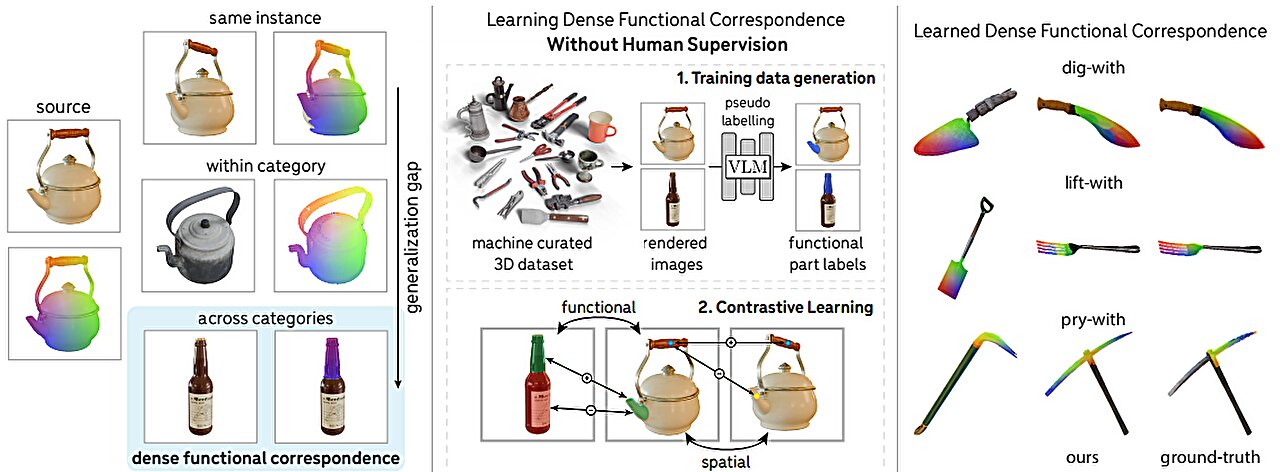Tech
AI model could boost robot intelligence via object recognition

Stanford researchers have developed an innovative computer vision model that recognizes the real-world functions of objects, potentially allowing autonomous robots to select and use tools more effectively.
In the field of AI known as computer vision, researchers have successfully trained models that can identify objects in two-dimensional images. It is a skill critical to a future of robots able to navigate the world autonomously. But object recognition is only a first step. AI also must understand the function of the parts of an object—to know a spout from a handle, or the blade of a bread knife from that of a butter knife.
Computer vision experts call such utility overlaps “functional correspondence.” It is one of the most difficult challenges in computer vision. But now, in a paper that will be presented at the International Conference on Computer Vision (ICCV 2025), Stanford scholars will debut a new AI model that can not only recognize various parts of an object and discern their real-world purposes but also map those at pixel-by-pixel granularity between objects.
A future robot might be able to distinguish, say, a meat cleaver from a bread knife or a trowel from a shovel and select the right tool for the job. Potentially, the researchers suggest, a robot might one day transfer the skills of using a trowel to a shovel—or of a bottle to a kettle—to complete a job with different tools.
“Our model can look at images of a glass bottle and a tea kettle and recognize the spout on each, but also it comprehends that the spout is used to pour,” explains co-first author Stefan Stojanov, a Stanford postdoctoral researcher advised by senior authors Jiajun Wu and Daniel Yamins. “We want to build a vision system that will support that kind of generalization—to analogize, to transfer a skill from one object to another to achieve the same function.”
Establishing correspondence is the art of figuring out which pixels in two images refer to the same point in the world, even if the photographs are from different angles or of different objects. This is hard enough if the image is of the same object but, as the bottle versus tea kettle example shows, the real world is rarely so cut-and-dried. Autonomous robots will need to generalize across object categories and to decide which object to use for a given task.
One day, the researchers hope, a robot in a kitchen will be able to select a tea kettle to make a cup of tea, know to pick it up by the handle, and to use the kettle to pour hot water from its spout.
Autonomy rules
True functional correspondence would make robots far more adaptable than they are currently. A household robot would not need training on every tool at its disposal but could reason by analogy to understand that while a bread knife and a butter knife may both cut, they each serve a specific purpose.
In their work, the researchers say, they have achieved “dense” functional correspondence, where earlier efforts were able to achieve only sparse correspondence to define only a few key points on each object. The challenge so far has been a paucity of data, which typically had to be amassed through human annotation.
“Unlike traditional supervised learning where you have input images and corresponding labels written by humans, it’s not feasible to humanly annotate thousands of pixels individually aligning across two different objects,” says co-first author Linan “Frank” Zhao, who recently earned his master’s in computer science at Stanford. “So, we asked AI to help.”
The team was able to achieve a solution with what is known as weak supervision—using vision-language models to generate labels to identify functional parts and using human experts only to quality-control the data pipeline. It is a far more efficient and cost-effective approach to training.
“Something that would have been very hard to learn through supervised learning a few years ago now can be done with much less human effort,” Zhao adds.
In the kettle and bottle example, for instance, each pixel in the spout of the kettle is aligned with a pixel in the mouth of the bottle, providing dense functional mapping between the two objects. The new vision system can spot function in structure across disparate objects—a valuable fusion of functional definition and spatial consistency.
Seeing the future
For now, the system has been tested only on images and not in real-world experiments with robots, but the team believes the model is a promising advance for robotics and computer vision. Dense functional correspondence is part of a larger trend in AI in which models are shifting from mere pattern recognition toward reasoning about objects. Where earlier models saw only patterns of pixels, newer systems can infer intent.
“This is a lesson in form following function,” says Yunzhi Zhang, a Stanford doctoral student in computer science. “Object parts that fulfill a specific function tend to remain consistent across objects, even if other parts vary greatly.”
Looking ahead, the researchers want to integrate their model into embodied agents and build richer datasets.
“If we can come up with a way to get more precise functional correspondences, then this should prove to be an important step forward,” Stojanov says. “Ultimately, teaching machines to see the world through the lens of function could change the trajectory of computer vision—making it less about patterns and more about utility.”
More information:
Weakly-Supervised Learning of Dense Functional Correspondences. dense-functional-correspondence.github.io/ On arXiv: DOI: 10.48550/arxiv.2509.03893
Citation:
AI model could boost robot intelligence via object recognition (2025, October 20)
retrieved 20 October 2025
from https://techxplore.com/news/2025-10-ai-boost-robot-intelligence-recognition.html
This document is subject to copyright. Apart from any fair dealing for the purpose of private study or research, no
part may be reproduced without the written permission. The content is provided for information purposes only.
Tech
WIRED Roundup: DOGE Isn’t Dead, Facebook Dating Is Real, and Amazon’s AI Ambitions

Leah Feiger: So it’s a really good question actually, and it’s one that I’ve thought about for quite some time. I think if it’s not annoying, I want to read this quote from Scott Kupor, the director of OPM and the former managing partner at Andreessen Horowitz, to be clear, just to remind everyone where people are coming from in this current administration. He posted this on X late last month, and this was part of Reuter’s reporting. So he posts, “The truth is, DOGE may not have centralized leadership under USDS anymore, but the principles of DOGE remain alive and well, deregulation, eliminating fraud, waste and abuse, reshaping the federal workforce, et cetera, et cetera, et cetera.” Which is the exact same, the thing that they’ve been saying this entire time, but it’s all smoke and mirrors, right? It’s like, oh no, no, well, DOGE doesn’t exactly exist anymore. There’s no Elon Musk character leading it, which Elon Musk himself said on the podcast with Joe Rogan last month as well. He’s like, “Yeah, once I left, they weren’t able to pick on anyone, but don’t worry, DOGE is still there.” So it feels wild to watch people fall for this and go like, “DOGE is gone now.” And I’m like, they’re literally telling us that it’s not.
Zoë Schiffer: I think one thing that does feel honestly true is that it is harder and harder to differentiate where DOGE stops and the Trump administration begins because they have infiltrated so many different parts of government and the DOGE ethos, what you’re talking about, deregulation, cost cuttings, zero-based budgeting, those have really become kind of table stakes for the admin, right?
Leah Feiger: I think that’s such a good point. And honestly, by the end of Elon Musk’s reign, something that kept coming up wasn’t necessarily that the Trump administration didn’t agree with DOGE’s ethos at all. It was that they didn’t really agree with how Musk was going about it. They didn’t like that he was stepping on Treasury Secretary Scott Bessent and having fights outside of the Oval Office. That was bad optics and that also wasn’t helping the Trump administration even look like they were on top of it.
Tech
Horses, the Most Controversial Game of the Year, Doesn’t Live Up to the Hype

The debate over Horses’ delisting is emblematic of a bigger fight that’s taken place this year, when platforms such as Steam and Itch.io yanked down “NSFW” and “porn” games in July. Developers, players, and trade organizations have continued to be vocal about developers’ creative rights to make games that deal with adult content.
“Developers shouldn’t have to compromise their creative vision, but we also have to acknowledge that games exist within capitalist structures where access to platforms determines livelihood,” says Jakin Vela, executive director of the International Game Developers Association, a nonprofit supporting game developers. “The key is informed decision-making and understanding what each platform allows, what risks exist, and whether your artistic goals outweigh those risks.”
Still, Vela says, these removals have exposed the fragility of developers’ economic security. “We should be concerned whenever a system allows a creator’s livelihood to be cut off without transparency or recourse,” he says. The video game industry is highly consolidated, with a handful of platforms controlling access to the vast majority of players. “That imbalance creates a structural issue, not necessarily because platforms enforce rules, but because there are so few viable alternatives.”
Santa Ragione’s future should not hinge on its ability to exist on Steam or any other platform. A bad project should not spell the end of a developer who is, for all the criticisms I have of its game, trying to say something. That part of this story may still yet have a happy, or at least a survivable, ending. The Streisand effect is paying off for Horses. On the digital distribution platform GOG, where it’s still available, the game is a top-seller.
Horses needs to be defended against censorship. It is also a bad game that should be examined as such. But while the conversation around Horses is still stalling out about why the game is allowed to exist, or how it’s not that offensive, the better question is why we really care about it at all—and why, as players, we feel so reluctant to talk about its failings like any other piece of media.
Tech
Silk & Snow Seemingly Cannot Miss—So Don’t Skip This Sale That Ends in 2 Days

I try to test every individual product critically and neutrally, but sometimes a brand comes along that seemingly cannot miss. We have liked everything we’ve tried from Silk & Snow, and right now the company is hosting a Cyber Week Sale that runs through December 7. You can save on some of our favorite bed frames and mattresses that we’ve tested long-term in our own homes, and if you prefer to browse on your own, the sale offers up to 35 percent off site-wide. I’ve rounded up the highlights on WIRED-tested gear below.
WIRED Featured Deals:
Silk & Snow Bed Frame With Drawer Storage for $560 ($140 off)
In our Bed Frame Buying Guide, I say that Silk & Snow could charge more for this bed frame—but right now, it’s 20 percent off. Assembly is a little bit annoying. But the fabric-covered headboard is gorgeous, and the frame is sturdy. My favorite part is the drawer cleverly concealed at the foot of the frame, with its two partitions and its magnetic closure. It does feel a little jarring if you open and close the drawer while your partner is in bed, but I like having extra storage in my room, especially since this frame is too low to the ground to allow for stashing things under it.
Silk & Snow S&S Organic Mattress for $765 ($235 off)
The S&S Organic Mattress is the best organic latex mattress. It’s very soft and offers a lot of pressure relief and support, but the responsive material means it’s better suited to solo sleepers than it is to couples. It feels like a soft, dense marshmallow, per our sleep reviewer Julia Forbes, who advises using lightweight blankets and cooling sheets if you’re a hot sleeper and also raved about the lengthy year-long sleep trial. As part of the Cyber Week sale, you can choose between a free sleep bundle (with a sheet set, a duvet, two microfiber pillows, and a mattress protector) or you can opt out of the bundle to get an extra 10 percent off your mattress.
Silk & Snow Wooden Bed Frame for $1,040 ($260 off)
This bed frame from Silk & Snow made our list of the best Thuma dupes. The Japanese joinery platform frame comes in your choice of natural rubber wood or cortado acacia wood, each in two different finishes. Assembly is pretty easy and doesn’t require any special tools, and you’ll get a robust five-year warranty. The resulting frame is sturdy and gorgeous, though we recommend having a helper around if you need to disassemble the frame to protect the finish on the wood.
Power up with unlimited access to WIRED. Get best-in-class reporting and exclusive subscriber content that’s too important to ignore. Subscribe Today.
-

 Tech6 days ago
Tech6 days agoGet Your Steps In From Your Home Office With This Walking Pad—On Sale This Week
-

 Sports5 days ago
Sports5 days agoIndia Triumphs Over South Africa in First ODI Thanks to Kohli’s Heroics – SUCH TV
-

 Fashion5 days ago
Fashion5 days agoResults are in: US Black Friday store visits down, e-visits up, apparel shines
-

 Entertainment5 days ago
Entertainment5 days agoSadie Sink talks about the future of Max in ‘Stranger Things’
-

 Politics5 days ago
Politics5 days agoElon Musk reveals partner’s half-Indian roots, son’s middle name ‘Sekhar’
-

 Tech5 days ago
Tech5 days agoPrague’s City Center Sparkles, Buzzes, and Burns at the Signal Festival
-

 Sports5 days ago
Sports5 days agoBroncos secure thrilling OT victory over Commanders behind clutch performances
-

 Sports5 days ago
Sports5 days agoF1 set for final-race showdown as Verstappen exploits McLaren blunder | The Express Tribune























